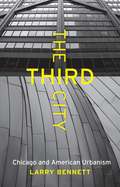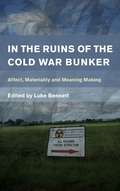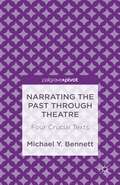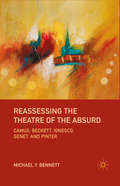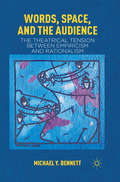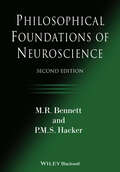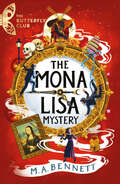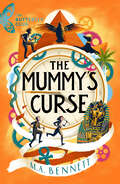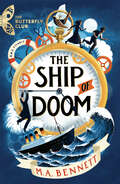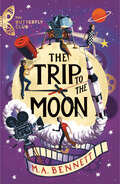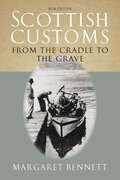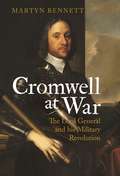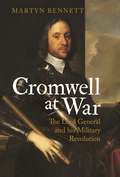- Table View
- List View
The Third City: Chicago and American Urbanism (Chicago Visions and Revisions)
by Larry BennettOur traditional image of Chicago—as a gritty metropolis carved into ethnically defined enclaves where the game of machine politics overshadows its ends—is such a powerful shaper of the city’s identity that many of its closest observers fail to notice that a new Chicago has emerged over the past two decades. Larry Bennett here tackles some of our more commonly held ideas about the Windy City—inherited from such icons as Theodore Dreiser, Carl Sandburg, Daniel Burnham, Robert Park, Sara Paretsky, and Mike Royko—with the goal of better understanding Chicago as it is now: the third city. Bennett calls contemporary Chicago the third city to distinguish it from its two predecessors: the first city, a sprawling industrial center whose historical arc ran from the Civil War to the Great Depression; and the second city, the Rustbelt exemplar of the period from around 1950 to 1990. The third city features a dramatically revitalized urban core, a shifting population mix that includes new immigrant streams, and a growing number of middle-class professionals working in new economy sectors. It is also a city utterly transformed by the top-to-bottom reconstruction of public housing developments and the ambitious provision of public works like Millennium Park. It is, according to Bennett, a work in progress spearheaded by Richard M. Daley, a self-consciously innovative mayor whose strategy of neighborhood revitalization and urban renewal is a prototype of city governance for the twenty-first century. The Third City ultimately contends that to understand Chicago under Daley’s charge is to understand what metropolitan life across North America may well look like in the coming decades.
The Third City: Chicago and American Urbanism (Chicago Visions and Revisions)
by Larry BennettOur traditional image of Chicago—as a gritty metropolis carved into ethnically defined enclaves where the game of machine politics overshadows its ends—is such a powerful shaper of the city’s identity that many of its closest observers fail to notice that a new Chicago has emerged over the past two decades. Larry Bennett here tackles some of our more commonly held ideas about the Windy City—inherited from such icons as Theodore Dreiser, Carl Sandburg, Daniel Burnham, Robert Park, Sara Paretsky, and Mike Royko—with the goal of better understanding Chicago as it is now: the third city. Bennett calls contemporary Chicago the third city to distinguish it from its two predecessors: the first city, a sprawling industrial center whose historical arc ran from the Civil War to the Great Depression; and the second city, the Rustbelt exemplar of the period from around 1950 to 1990. The third city features a dramatically revitalized urban core, a shifting population mix that includes new immigrant streams, and a growing number of middle-class professionals working in new economy sectors. It is also a city utterly transformed by the top-to-bottom reconstruction of public housing developments and the ambitious provision of public works like Millennium Park. It is, according to Bennett, a work in progress spearheaded by Richard M. Daley, a self-consciously innovative mayor whose strategy of neighborhood revitalization and urban renewal is a prototype of city governance for the twenty-first century. The Third City ultimately contends that to understand Chicago under Daley’s charge is to understand what metropolitan life across North America may well look like in the coming decades.
The Third City: Chicago and American Urbanism (Chicago Visions and Revisions)
by Larry BennettOur traditional image of Chicago—as a gritty metropolis carved into ethnically defined enclaves where the game of machine politics overshadows its ends—is such a powerful shaper of the city’s identity that many of its closest observers fail to notice that a new Chicago has emerged over the past two decades. Larry Bennett here tackles some of our more commonly held ideas about the Windy City—inherited from such icons as Theodore Dreiser, Carl Sandburg, Daniel Burnham, Robert Park, Sara Paretsky, and Mike Royko—with the goal of better understanding Chicago as it is now: the third city. Bennett calls contemporary Chicago the third city to distinguish it from its two predecessors: the first city, a sprawling industrial center whose historical arc ran from the Civil War to the Great Depression; and the second city, the Rustbelt exemplar of the period from around 1950 to 1990. The third city features a dramatically revitalized urban core, a shifting population mix that includes new immigrant streams, and a growing number of middle-class professionals working in new economy sectors. It is also a city utterly transformed by the top-to-bottom reconstruction of public housing developments and the ambitious provision of public works like Millennium Park. It is, according to Bennett, a work in progress spearheaded by Richard M. Daley, a self-consciously innovative mayor whose strategy of neighborhood revitalization and urban renewal is a prototype of city governance for the twenty-first century. The Third City ultimately contends that to understand Chicago under Daley’s charge is to understand what metropolitan life across North America may well look like in the coming decades.
The Third City: Chicago and American Urbanism (Chicago Visions and Revisions)
by Larry BennettOur traditional image of Chicago—as a gritty metropolis carved into ethnically defined enclaves where the game of machine politics overshadows its ends—is such a powerful shaper of the city’s identity that many of its closest observers fail to notice that a new Chicago has emerged over the past two decades. Larry Bennett here tackles some of our more commonly held ideas about the Windy City—inherited from such icons as Theodore Dreiser, Carl Sandburg, Daniel Burnham, Robert Park, Sara Paretsky, and Mike Royko—with the goal of better understanding Chicago as it is now: the third city. Bennett calls contemporary Chicago the third city to distinguish it from its two predecessors: the first city, a sprawling industrial center whose historical arc ran from the Civil War to the Great Depression; and the second city, the Rustbelt exemplar of the period from around 1950 to 1990. The third city features a dramatically revitalized urban core, a shifting population mix that includes new immigrant streams, and a growing number of middle-class professionals working in new economy sectors. It is also a city utterly transformed by the top-to-bottom reconstruction of public housing developments and the ambitious provision of public works like Millennium Park. It is, according to Bennett, a work in progress spearheaded by Richard M. Daley, a self-consciously innovative mayor whose strategy of neighborhood revitalization and urban renewal is a prototype of city governance for the twenty-first century. The Third City ultimately contends that to understand Chicago under Daley’s charge is to understand what metropolitan life across North America may well look like in the coming decades.
The Third City: Chicago and American Urbanism (Chicago Visions and Revisions)
by Larry BennettOur traditional image of Chicago—as a gritty metropolis carved into ethnically defined enclaves where the game of machine politics overshadows its ends—is such a powerful shaper of the city’s identity that many of its closest observers fail to notice that a new Chicago has emerged over the past two decades. Larry Bennett here tackles some of our more commonly held ideas about the Windy City—inherited from such icons as Theodore Dreiser, Carl Sandburg, Daniel Burnham, Robert Park, Sara Paretsky, and Mike Royko—with the goal of better understanding Chicago as it is now: the third city. Bennett calls contemporary Chicago the third city to distinguish it from its two predecessors: the first city, a sprawling industrial center whose historical arc ran from the Civil War to the Great Depression; and the second city, the Rustbelt exemplar of the period from around 1950 to 1990. The third city features a dramatically revitalized urban core, a shifting population mix that includes new immigrant streams, and a growing number of middle-class professionals working in new economy sectors. It is also a city utterly transformed by the top-to-bottom reconstruction of public housing developments and the ambitious provision of public works like Millennium Park. It is, according to Bennett, a work in progress spearheaded by Richard M. Daley, a self-consciously innovative mayor whose strategy of neighborhood revitalization and urban renewal is a prototype of city governance for the twenty-first century. The Third City ultimately contends that to understand Chicago under Daley’s charge is to understand what metropolitan life across North America may well look like in the coming decades.
The Third City: Chicago and American Urbanism (Chicago Visions and Revisions)
by Larry BennettOur traditional image of Chicago—as a gritty metropolis carved into ethnically defined enclaves where the game of machine politics overshadows its ends—is such a powerful shaper of the city’s identity that many of its closest observers fail to notice that a new Chicago has emerged over the past two decades. Larry Bennett here tackles some of our more commonly held ideas about the Windy City—inherited from such icons as Theodore Dreiser, Carl Sandburg, Daniel Burnham, Robert Park, Sara Paretsky, and Mike Royko—with the goal of better understanding Chicago as it is now: the third city. Bennett calls contemporary Chicago the third city to distinguish it from its two predecessors: the first city, a sprawling industrial center whose historical arc ran from the Civil War to the Great Depression; and the second city, the Rustbelt exemplar of the period from around 1950 to 1990. The third city features a dramatically revitalized urban core, a shifting population mix that includes new immigrant streams, and a growing number of middle-class professionals working in new economy sectors. It is also a city utterly transformed by the top-to-bottom reconstruction of public housing developments and the ambitious provision of public works like Millennium Park. It is, according to Bennett, a work in progress spearheaded by Richard M. Daley, a self-consciously innovative mayor whose strategy of neighborhood revitalization and urban renewal is a prototype of city governance for the twenty-first century. The Third City ultimately contends that to understand Chicago under Daley’s charge is to understand what metropolitan life across North America may well look like in the coming decades.
In the Ruins of the Cold War Bunker: Affect, Materiality and Meaning-making (PDF)
by Luke BennettDuring the Cold War military and civil defence bunkers were an evocative materialisation of deadly military stand-off. They were also a symbol of a deeply affective, pervasive anxiety about the prospect of world-destroying nuclear war. But following the sudden fall of the Berlin Wall in 1989 these sites were swiftly abandoned, and exposed to both material and semantic ruination. This volume investigates the uses and meanings now projected onto these seeming blank, derelict spaces. It explores how engagements with bunker ruins provide fertile ground for the study of improvised meaning making, place-attachment, hobby practices, social materiality and trauma studies. With its commentators ranging across the arts and humanities and the social sciences, this multi-disciplinary collection sets a concern with the phenomenological qualities of these places as contemporary ruins - and of their strange affective affordances - alongside scholarship examining how these places embody, and/or otherwise connect with their Cold War originations and purpose both materially and through memory and trauma. Each contribution reflexively considers the process of engaging with these places - and whether via the archive or direct sensory immersion. In doing so the book broadens the bunker's contemporary signification and contributes to theoretically informed analysis of ruination, place attachment, meaning making, and material culture.
Narrating the Past through Theatre: Four Crucial Texts
by M. BennettThis cutting-edge title explores how narrating the past both conflicts and creates an interesting relationship with drama's 'continuing present' that arcs towards an unpredictable future. Theatre both brings the past alive and also fixes it, but through the performance process, allowing the past to be molded for future (not-yet-existent) audiences.
Reassessing the Theatre of the Absurd: Camus, Beckett, Ionesco, Genet, and Pinter
by M. BennettFifty years after the publication of Martin Esslin's The Theatre of the Absurd , which suggests that 'absurd' plays purport the meaninglessness of life, this book uses the works of five major playwrights of the 1950s to provide a timely reassessment of one of the most important theatre 'movements' of the 20th century.
Words, Space, and the Audience: The Theatrical Tension between Empiricism and Rationalism
by M. BennettIn this unique study, Michael Y. Bennett re-reads four influential modern plays alongside their contemporary debates between rationalism and empiricism to show how these monumental achievements were thoroughly a product of their time, but also universal in their epistemological quest to understand the world through a rational and/or empirical model. Bennett contends that these plays directly engage in their contemporary epistemological debates rather than through the lens of a specific philosophy. Besides producing new, insightful readings of heavily-studied plays, the interdisciplinary (historical, philosophical, dramatic, theatrical, and literary) frame Bennett constructs allows him to investigate one of the most fundamental questions of the theatre - how does meaning get made? Bennett suggests that the key to unlocking theatrical meaning is exploring the tension between empirical and rational modes of understanding. The book concludes with an interview with performance artist Coco Fusco.
Philosophical Foundations of Neuroscience
by M. R. Bennett P. M. HackerThe second edition of the seminal work in the field—revised, updated, and extended In Philosophical Foundations of Neuroscience, M.R. Bennett and P.M.S. Hacker outline and address the conceptual confusions encountered in various neuroscientific and psychological theories. The result of a collaboration between an esteemed philosopher and a distinguished neuroscientist, this remarkable volume presents an interdisciplinary critique of many of the neuroscientific and psychological foundations of modern cognitive neuroscience. The authors point out conceptual entanglements in a broad range of major neuroscientific and psychological theories—including those of such neuroscientists as Blakemore, Crick, Damasio, Dehaene, Edelman, Gazzaniga, Kandel, Kosslyn, LeDoux, Libet, Penrose, Posner, Raichle and Tononi, as well as psychologists such as Baar, Frith, Glynn, Gregory, William James, Weiskrantz, and biologists such as Dawkins, Humphreys, and Young. Confusions arising from the work of philosophers such as Dennett, Chalmers, Churchland, Nagel and Searle are subjected to detailed criticism. These criticisms are complemented by constructive analyses of the major cognitive, cogitative, emotional and volitional attributes that lie at the heart of cognitive neuroscientific research. Now in its second edition, this groundbreaking work has been exhaustively revised and updated to address current issues and critiques. New discussions offer insight into functional magnetic resonance imaging (fMRI), the notions of information and representation, conflict monitoring and the executive, minimal states of consciousness, integrated information theory and global workspace theory. The authors also reply to criticisms of the fundamental arguments posed in the first edition, defending their conclusions regarding mereological fallacy, the necessity of distinguishing between empirical and conceptual questions, the mind-body problem, and more. Essential as both a comprehensive reference work and as an up-to-date critical review of cognitive neuroscience, this landmark volume: Provides a scientifically and philosophically informed survey of the conceptual problems in a wide variety of neuroscientific theories Offers a clear and accessible presentation of the subject, minimizing the use of complex philosophical and scientific jargon Discusses how the ways the brain relates to the mind affect the intelligibility of neuroscientific research Includes fresh insights on mind-body and mind-brain relations, and on the relation between the notion of person and human being Features more than 100 new pages and a wealth of additional diagrams, charts, and tables Continuing to challenge and educate readers like no other book on the subject, the second edition of Philosophical Foundations of Neuroscience is required reading not only for neuroscientists, psychologists, and philosophers, but also for academics, researchers, and students involved in the study of the mind and consciousness.
Philosophical Foundations of Neuroscience
by M. R. Bennett P. M. HackerThe second edition of the seminal work in the field—revised, updated, and extended In Philosophical Foundations of Neuroscience, M.R. Bennett and P.M.S. Hacker outline and address the conceptual confusions encountered in various neuroscientific and psychological theories. The result of a collaboration between an esteemed philosopher and a distinguished neuroscientist, this remarkable volume presents an interdisciplinary critique of many of the neuroscientific and psychological foundations of modern cognitive neuroscience. The authors point out conceptual entanglements in a broad range of major neuroscientific and psychological theories—including those of such neuroscientists as Blakemore, Crick, Damasio, Dehaene, Edelman, Gazzaniga, Kandel, Kosslyn, LeDoux, Libet, Penrose, Posner, Raichle and Tononi, as well as psychologists such as Baar, Frith, Glynn, Gregory, William James, Weiskrantz, and biologists such as Dawkins, Humphreys, and Young. Confusions arising from the work of philosophers such as Dennett, Chalmers, Churchland, Nagel and Searle are subjected to detailed criticism. These criticisms are complemented by constructive analyses of the major cognitive, cogitative, emotional and volitional attributes that lie at the heart of cognitive neuroscientific research. Now in its second edition, this groundbreaking work has been exhaustively revised and updated to address current issues and critiques. New discussions offer insight into functional magnetic resonance imaging (fMRI), the notions of information and representation, conflict monitoring and the executive, minimal states of consciousness, integrated information theory and global workspace theory. The authors also reply to criticisms of the fundamental arguments posed in the first edition, defending their conclusions regarding mereological fallacy, the necessity of distinguishing between empirical and conceptual questions, the mind-body problem, and more. Essential as both a comprehensive reference work and as an up-to-date critical review of cognitive neuroscience, this landmark volume: Provides a scientifically and philosophically informed survey of the conceptual problems in a wide variety of neuroscientific theories Offers a clear and accessible presentation of the subject, minimizing the use of complex philosophical and scientific jargon Discusses how the ways the brain relates to the mind affect the intelligibility of neuroscientific research Includes fresh insights on mind-body and mind-brain relations, and on the relation between the notion of person and human being Features more than 100 new pages and a wealth of additional diagrams, charts, and tables Continuing to challenge and educate readers like no other book on the subject, the second edition of Philosophical Foundations of Neuroscience is required reading not only for neuroscientists, psychologists, and philosophers, but also for academics, researchers, and students involved in the study of the mind and consciousness.
The Mona Lisa Mystery: Book 3 - A time-travelling adventure around Paris and Florence (The Butterfly Club #3)
by M.A. BennettWould you risk the future to change the past?Luna, Konstantin and Aidan are time-travelling thieves working for The Butterfly Club.When they are asked to steal a little-known painting called the Mona Lisa, Aidan can only think of one man who can make things disappear – the magician, Harry Houdini. And as luck would have it, Houdini cannot resist a challenge.The three children and Houdini travel to 1911 Paris where they face an impossible task – stealing a painting right off the wall of the fortress-like Louvre Museum.As Houdini prepares for the theft, a heist which will require him to pull off his greatest ever trick, the time-thieves realise that the Mona Lisa is smiling because she holds a secret. Her creator, Leonardo Da Vinci, hid mysterious codes within the painting.The race is on to solve the puzzle in time...
The Mummy's Curse: Book 2 - A time-travelling adventure to discover the secrets of Tutankhamun (The Butterfly Club #2)
by M.A. BennettWould you risk the future to change the past?Greenwich, London, 1894.Luna, Konstantin and Aidan are time-travelling thieves, stealing artefacts from the future to bring progress forward. And they are about to venture on their most treacherous mission.For The Butterfly Club have their eyes on a shiny new prize. In Egypt's Valley of the Kings a man named Howard Carter will stumble upon an unimaginable treasure – Tutankhamun's mummy: the greatest archaeological discovery of all time.The three children are given an impossible task: travel to 1922 and uncover the mummy first. But when the time-thieves disturb Tutankhamun's long sleep they wake something else too – a deadly and ancient curse. And now they must face the terrifying consequences of their actions...
The Ship of Doom: Book 1 - A time-travelling adventure set on board the Titanic (The Butterfly Club #1)
by M.A. Bennett'A hugely entertaining mystery' – Fiona Noble, The Bookseller Children's Previews 'One to Watch' Greenwich, London, 15th February 1894.Luna thinks that an evening at her aunt's butterfly club sounds deathly boring.But it turns out that the meeting, held in the Butterfly Room at the Greenwich Observatory, is not at all as Luna expects. The Butterfly Club is a society with an unusual secret . . . they use time travel to plunder the future for wonders.Together with her friends, Konstantin and Aidan, and a clockwork cuckoo, Luna boards the Time Train. The gang travel to 1912 and find themselves aboard a great ship travelling from Southampton to New York. They locate a man called Guglielmo Marconi and his new invention: the wireless radio. But as the ship heads into icy waters, they discover its name:The RMS TITANICCan Luna and the boys save Marconi and his invention from the doomed ship?Can they get the radio back home to the Butterfly Club?And how will their actions change the rest of time?
The Trip to the Moon: Book 4 - A time-travelling adventure (The Butterfly Club #4)
by M.A. BennettThe adventures of the time-travelling Butterfly Club continue . . .Film is set to become the new craze. Butterfly Club member and filmmaker Georges Méliès pleads to be allowed to go forward in time to harvest a movie camera from the future to make his ambitious film, A Trip to the Moon.The Butterfly Club call up Professor Lorenz's hologram from 1969. The professor reports that all of America is abuzz too, with the most ambitious scientific project in history – an actual trip to the moon. But the mission has stalled in the most terrible way – an accident on the launchpad resulted in the astronauts being trapped in a fatal fire.For the first time ever it is the professor who asks the time thieves for help – he invites them to come to 1969 and stop the dreadful accident, and make sure the trip to the moon can go ahead.
A Child Of Her Time: a beautifully moving coming of age saga you won’t be able to put down
by Maggie BennettSet in the aftermath of the Great War A Child of Her Time is a story of prejudice, passion and one woman's struggle to fight for what she really wants in life - against all oddsAt twenty-five, teacher Phyllis Bird is still living with her parents in a quiet Hampshire village. With so many young men lost in the Great War, including her own brothers, her life is empty and her future without hope. Until, desperate to break out of her mundane existence, she decides to take up the position of nursery maid in the London home of acclaimed playwright Harold Berridge. Befriended by the actress Maud Ling and thrown into the glamorous but fickle world of the cinema, Phyllis falls passionately in love with Maud's younger brother Teddy. But Teddy's heart lies elsewhere, and when tragedy strikes the Berridge household a heartbroken Phyllis is forced to leave. Six months later, Phyllis has started to rebuild her life but her world is turned upside down once more when she is invited to a party at Maud Ling's film studios. For there she falls under the spell of the charming but devious American actor Denver Towers, with disastrous consequences...
Scottish Customs: From the Cradle to the Grave
by Margaret BennettYet again Margaret Bennett has produced a fascinating book...excellent value for money' - J.C. Massy, Lore and Language 'Margaret Bennett has given us another magic book, brought together from many books of the past as well as hitherto unpublished interview material, private manuscripts, wonderful miniatures of folklore, wise and charming commentary on human personality in a dazzling profusion' - Owen Dudley Edwards A highly readable and absorbing anthology of traditional Scottish customs and rites of passage, Scottish Customs from the Cradle to the Grave draws upon a broad range of literary and oral sources. Scotland has been fortunate to have written accounts of intrepid early travellers such as Martin Martin, Edward Burt and John Lane Buchanan, and extracts from their writing are found alongside modern interviews made by Margaret Bennett and researchers from the School of Scottish Studies at Edinburgh University. This expanded edition includes a large amount of new material. The result is a detailed and comprehensive picture of social behaviour in Scotland over the last 400 years. The book is divided into three sections, each covering a stage in the cycle of life: Childbirth and infancy; Love, courtship and marriage; Death The first edition was originally published by Polygon and was joint runner-up of the 1993 Katharine Briggs Folklore Award.
The Civil Wars Experienced: Britain and Ireland, 1638-1661
by Martyn BennettThe Civil Wars Experienced is an exciting new history of the civil wars, which recounts their effects on the 'common people'. This engaging survey throws new light onto a century of violence and political and social upheavalBy looking at personal sources such as diaries, petitions, letters and social sources including the press, The Civil War Experienced clearly sets out the true social and cultural effects of the wars on the peoples of England, Scotland, Wales and Ireland and how common experiences transcended national and regional boundaries. It ranges widely from the Orkneys to Galway and from Radnorshire to Norfolk.The Civil Wars Experienced explores exactly how far-reaching the changes caused by civil wars actually were for both women and men and carefully assesses individual reactions towards them. For most people fear, familial concerns and material priorities dictated their lives, but for others the civil revolutions provided a positive force for their own spiritual and religious development. By placing the military and political developments of the civil wars in a social context, this book portrays a very different interpretation of a century of regicide and republic.
The Civil Wars Experienced: Britain and Ireland, 1638-1661
by Martyn BennettThe Civil Wars Experienced is an exciting new history of the civil wars, which recounts their effects on the 'common people'. This engaging survey throws new light onto a century of violence and political and social upheavalBy looking at personal sources such as diaries, petitions, letters and social sources including the press, The Civil War Experienced clearly sets out the true social and cultural effects of the wars on the peoples of England, Scotland, Wales and Ireland and how common experiences transcended national and regional boundaries. It ranges widely from the Orkneys to Galway and from Radnorshire to Norfolk.The Civil Wars Experienced explores exactly how far-reaching the changes caused by civil wars actually were for both women and men and carefully assesses individual reactions towards them. For most people fear, familial concerns and material priorities dictated their lives, but for others the civil revolutions provided a positive force for their own spiritual and religious development. By placing the military and political developments of the civil wars in a social context, this book portrays a very different interpretation of a century of regicide and republic.
Cromwell at War: The Lord General and his Military Revolution
by Martyn BennettOliver Cromwell was arguably the most significant political figure in the early modern history of the British Isles. Yet he was also a military leader, with significant battlefield victories to his credit. Martyn Bennett here provides the first military biography of Cromwell in the context of the seventeenth century Military Revolution. After commanding a small troop in 1643 and, without prior military experience, Cromwell rose to lead the cavalry regiments of the Eastern Association Army and the New Model Army to final victory at Worcester in 1651 and sealed the victory of the Parliamentary forces in Ireland and Scotland, becoming Lord General in 1650. Martyn Bennett analyses Cromwell's military talents and generalship, in addition to his well-attested powerful and even brutal discipline and religious fervour. He examines the controversial Irish campaigns as well as modern accusations of genocide. In providing new perspectives on Cromwell's military career, Bennett adds to our understanding of England's only non-royal head of state.
Cromwell at War: The Lord General and his Military Revolution
by Martyn BennettMartyn Bennett here provides the first military biography of Cromwell in the context of the seventeenth century Military Revolution. After commanding a small troop in 1643 and, without prior military experience, Cromwell rose to lead the cavalry regiments of the Eastern Association Army and the New Model Army to final victory at Worcester in 1651 and sealed the victory of the Parliamentary forces in Ireland and Scotland, becoming Lord General in 1650. Martyn Bennett analyses Cromwell's military talents and generalship, in addition to his well-attested powerful and even brutal discipline and religious fervour. He examines the controversial Irish campaigns as well as modern accusations of genocide. In providing new perspectives on Cromwell's military career, Bennett adds to our understanding of England's only non-royal head of state.
The English Civil War: A Historical Companion (Seminar Studies)
by Martyn BennettThe English Civil War" was a series of armed conflicts and political upheavals which spanned the entirety of the British Isles in the mid-seventeenth century. It was fought on a wide range of religious, political and racial issues, and succeeded in dividing the traditional loyalties of class, friendship and family ties within all four kingdoms. This unprecedented period of disruption resulted in far-reaching political revolution, the re-evaluation of political representation and social structure, and ultimately laid the foundations of the British constitution we know today. Martyn Bennett introduces the reader to the main debates surrounding the Civil War, from the St Giles riots in Edinburgh in 1637 to the restoration of Charles II on 8 May 1660, and includes biographies of the key personalities, key events, battles, military institutions of the conflict, and covers the run-up to the conflict, the wars themselves and its aftermath. This comprehensive A-Z companion to the history of the civil wars provides all the facts and figures that an armchair general would ever need.
The English Civil War 1640-1649
by Martyn BennettThe English Civil War (1642-53) is one of the most crucial periods in British history. Martyn Bennett introduces the reader to the main debates surrounding the Civil War which continue to be debated by historians. He considers the repercussions both on government and religion, of Parliament's failure to secure stability after the Royalist defeat in 1646, and argues that this opened the way for far more radical reforms. The book deals with the military campaigns in all four nations, placing the war in its full British and Irish context.
The English Civil War 1640-1649
by Martyn BennettThe English Civil War (1642-53) is one of the most crucial periods in British history. Martyn Bennett introduces the reader to the main debates surrounding the Civil War which continue to be debated by historians. He considers the repercussions both on government and religion, of Parliament's failure to secure stability after the Royalist defeat in 1646, and argues that this opened the way for far more radical reforms. The book deals with the military campaigns in all four nations, placing the war in its full British and Irish context.
